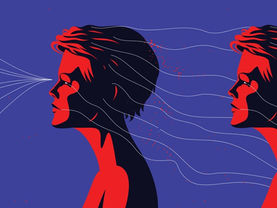Vitiligo: A Journey Through Skin, Science, and Society
- Kankana Dutta

- Jun 26
- 5 min read
All of us have likely encountered someone with milky white spots on their body at some point in our lives—it could be a friend, a coworker, or a teacher. Often, we are quick to judge them and label them as “different,” but we rarely take the time to understand the root cause of such lesions on otherwise normal skin. These patches are caused by vitiligo.
What is Vitiligo?
As mentioned earlier, Vitiligo is an autoimmune disease, in which our own body destroys our melanocytes, the cells which produce the pigment that colours our skin. Unlike albinism, which involves a complete genetic loss of pigment, vitiligo presents in localized patches, usually appearing before the age of 20. Initially, it starts with small patches (mostly symmetrically) across hands, feet or face, but if left unattended with no medical intervention it can spread rapidly. Sometimes, there can be a rapid loss of colour or pigment and even cover a large area.
Now let us focus on the number of types of vitiligo:
Vitiligo is of three types-
Segmental Vitiligo: In segmental vitiligo (also known as unilateral or localised vitiligo), the white patches only affect one area of your body. Segmental vitiligo is less common than non-segmental vitiligo.
Non-segmental/Generalised vitiligo: In this type, vitiligo appears symmetrically without segmentation, it can appear on both hands, knees, feet, arms etc body parts. Non-segmental vitiligo is more widely spread.
Universal Vitiligo: Universal vitiligo is a rare type in which the entire skin loses its pigment, resulting in widespread depigmentation.
What causes Vitiligo?
The exact causes of vitiligo are still not fully understood, but research suggests a combination of genetic, autoimmune, and environmental factors play a role. Here are some of the most prominent factors associated with vitiligo:
Autoimmune Response: In vitiligo, the immune system mistakenly attacks melanocytes, causing the pigment-producing cells to die. However, this autoimmune attack is the primary reason for the loss of pigmentation in vitiligo.
Genetics: Family history plays a significant role in the development of vitiligo. Specific genes such as NLRP1 and PTPN22, which are related to immune regulation, have been linked to an increased risk.
Environmental Triggers: Some studies suggest that environmental factors, such as exposure to certain chemicals or stress, may trigger or exacerbate vitiligo in individuals who are genetically predisposed.
Oxidative Stress: An imbalance in the body’s ability to handle oxidative stress may also contribute to the destruction of melanocytes in people with vitiligo.
Symptoms of Vitiligo:
Well-defined white patches, often symmetrical, with sharp borders.
Patches commonly appear on areas exposed to the sun, such as the face, hands, and feet.
Over time, patches may spread to other parts of the body, and hair within the affected areas may also lose color.
Vitiligo typically has no itching, pain, or other physical symptoms apart from discoloration.
Diagnosis and Treatment:
Vitiligo can usually be diagnosed through a detailed medical history and careful skin examination. If the diagnosis is uncertain, a dermatologist may use a Wood’s Lamp, a specialized ultraviolet (UV) light that makes depigmented areas appear bright white, distinguishing them from other skin conditions like fungal infections.
Since people with vitiligo have a higher risk of developing other autoimmune diseases, blood tests (such as thyroid function tests and antinuclear antibody tests) are often recommended to screen for associated conditions.
While vitiligo currently has no definitive cure, various treatment options can help restore skin color, reduce the appearance of patches, and prevent further progression.
Topical Medicines
Corticosteroids (e.g., clobetasol):Help limit the spread of depigmentation and may restore some pigment in early stages. However, long-term use can lead to side effects such as skin thinning (atrophy), stretch marks, and increased skin fragility.
Calcineurin Inhibitors (e.g., tacrolimus, pimecrolimus):These are often used on sensitive areas like the face and have fewer side effects compared to corticosteroids.
Vitamin D Analogues (e.g., calcipotriene):Often combined with corticosteroids to enhance pigment restoration.
Light Therapy
Light therapy exposes your skin to a type of ultraviolet (UV) light that can restore your natural skin color. If a large area of your body needs treatment, your dermatologist may prescribe a type of light therapy called phototherapy.
During phototherapy, you expose your skin to UV light for a specific amount of time. A dermatologist calculates the right amount of time for each patient. Light therapy is most effective at restoring color to the face and neck. Like other treatments for vitiligo, the lips, tips of the fingers, and toes are least responsive to treatment with light therapy.
Makeup, self-tanner, skin dye
These methods help to even out the skin tone and give a polished look. However, these are not permanent or medicinal.
Diet and supplements for vitiligo
You may have heard that certain vitamins, minerals, amino acids, or enzymes like Folic Acid, Zinc, Vitamin C, Vitamin B12 can restore your natural skin color. Researchers are studying the effects that these may have on vitiligo. More research is needed to determine whether any diet or supplements can effectively treat vitiligo.
Case Study:
A study conducted among 120 patients at the outpatient dermatology department of a service hospital in India provided valuable insights into vitiligo's clinical patterns (Source: Sharma et al., Indian Journal of Dermatology, 2001).
Study Results:
The youngest patient was a 2-year-old girl; the oldest was a 65-year-old male.
In 52 (43.2%) patients, disease onset occurred before the age of 20.
Disease duration ranged from 2 months to 10 years.
Eight cases had a family history of vitiligo, including one instance where a mother and her two daughters were affected.
Exposed areas were most commonly involved, observed in 80 (66.6%) cases.
Bilaterally symmetrical lesions were present in 8 (6.6%) cases.
The legs were the most frequently affected site, noted in 60 (50%) cases.
Social Stigma and Misconceptions around Vitiligo and Its Impact on Mental Well-being
Our society, since the beginning of time, has set a few rules or standards as to how a person should behave or appear, and anyone who doesn’t fit into those check boxes of conventional “beauty” is ostracised or alienated. Especially in cultures where darker skin is prevalent, the white patches of vitiligo create a stark contrast, leading to the perception of disfigurement. Some other prevalent misconceptions around vitiligo include that it is a form of leprosy, it is a sign of uncleanliness or that it is largely diet influenced. All these concepts have no scientific basis and simply cause a rise of anxiety, stress, depression, and embarrassment in patients suffering from vitiligo.
As a community, it is our responsibility to remind them, everyone has their own perfect, and it is not imperative to fit into someone else’s definition of perfect.















Comments